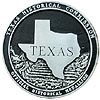| |
|
|
Dodd's Creek Bridge |
|
 |
|
Salado,
TX,
USA
|
| |
| |
|
Texas State
Historical Marker |
(Lenticular Truss Bridge) One of many patented truss designs developed by American inventors and engineers in the mid- to late-19th century, this 87-foot lenticular truss bridge represents an unusual truss type in the United States. The lenticular design features a curved top and bottom chord which forms a lens shape. The patent, issued to William O. Douglas of Connecticut in 1878, was the only one given for a lenticular truss bridge in the United States. Most were constructed in the New England area and in New York state. Through the efforts of William Payson, a salesman for Douglas' Berlin Iron Bridge Company, Texas acquired at least a dozen truss bridges in the late 19th century. The Coryell County Commissioners Court contracted with the Berlin Iron Bridge Company to build four lenticular truss bridges for $16,500 in 1889. This bridge originally was located across Cowhouse Creek and later was moved to Dodd's Creek. In 1990 the Texas Historical Commission and the Texas Department of Transportation identified eight lenticular truss bridges surviving in Texas. Four of the spans were located in San Antonio; the other four were positioned on out-of-service roadways. The only examples of this rare bridge type west of the Mississippi, they are recognized as historically significant engineering structures. The Society for Industrial Archeology and Historic American Engineering Record, a branch of the National Park Service, also have recognized the importance of the Texas lenticular bridges as products of a short-lived but important period of bridge technology in 19th century engineering history. The Dodd's Creek bridge was moved to this site in 1997 to improve the flow of traffic, protect pedestrians and enhance the Salado Historic District. (2000)
This page last updated: 7/15/2008 |
|
|
|
|


